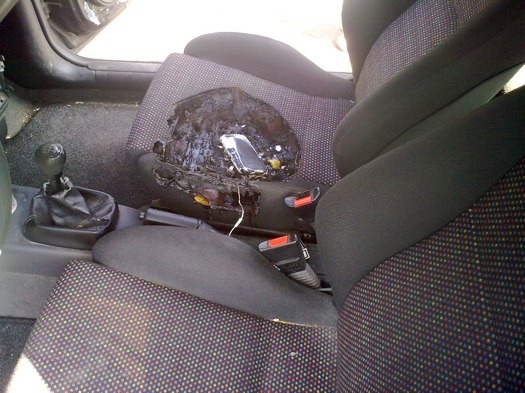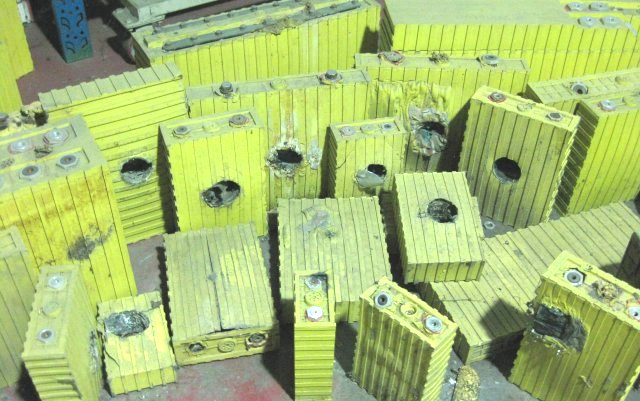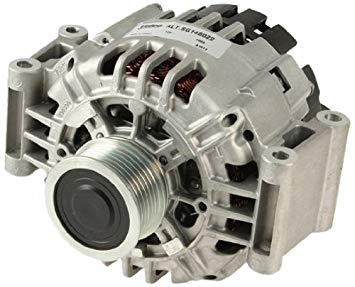Misconceptions
These days, everyone has experience with Lithium powered consumer electronics and these experiences might make it hard to believe that Lithium batteries will easily last more than 10 years on a ship. Also, many have heard about Lithium batteries exploding and/or catching fire, and the last thing you need on the middle of the ocean is a big heavy Lithium battery bursting into flames.

There are a few explanations for Lithium batteries not living up to their promised performance and luckily none of these issues apply to ships. One key difference is that, unlike on boats, consumer electronics rarely use LiFePO4 batteries. Especially with mobile phones and other gadgets, size is everything, and LiFePO4 batteries just don't posess the best size-to-power ratio. So other types of Lithium batteries are used, which are optimized for size, but not for durability and safety. On a ship however, the Lithium battery doesn't have to fit into a ridiculously thin briefcase and even the "not smallest" LiFePO4 batteries are way much smaller than the lead-acid batteries people are accustomed to.
Durability
If you are like me, you leave your laptop almost always plugged in, and after a year when you want to work "cordless" you discover that the "hardly used" battery doesn't last very long anymore. Also, after one year of use, the battery of the mobile phone lost a significant amount of charge capacity as well. Why is this?
- Chemistry. LiFePO4 batteries are champions for their durability and most other Lithium types have less capability to cycle than LiFePO4's. But these other types are so thin, which is what the gadget-fashion dictates consumers to like, so you will end up with batteries which have been optimized for size but not for safety and durability.
- Charging too much. Lithium batteries hate to be fully charged, but yet this is what most people do. You want your flashlight, electric drill, laptop, etc. always "ready" and fully charged. This results in a lithium battery which spends most of its time in a fully charged state. But to remain in a fully charged state is what kills Lithium batteries.
- Charging too far. Did I mention that size is everything? One way to shrink the size of a battery is to make more "optimal" use of its capacity: to charge it almost to bursting and to discharge it very deeply. Especially charging too far is bad for Lithium batteries. It would be better to have a slightly larger battery and leave a bit of capacity on both ends and get more than double the lifetime out of it, but hey, I might not be the typical consumer.
- Charging too fast. We all love to be able to charge the darn cell phone in about 2 hours, but this is not the best thing for its longevity. Battery manufacturers, who otherwise like to boost the best possible specifications, usually recommend strongly agains charging the battery with more current than one third of its rated capacity, which means that charging should at least take 3 hours under optimal conditions. Charging too much promotes harmfull lithium plating.
- Heat. Lithium batteries suffer badly from temperatures anywhere above 30 degrees Celcius, but mobile phones and laptops tend to become quite warm, sometimes almost too hot to touch. High temperatures reduce the lifetime of the batteries significantly. On a ship however, you can place the batteries in a compartment where the temperature never elevates much over the surrounding seawater, which is, even in the tropics, almost never above 30 degrees Celcius.
- Programmed failure. It is not in the interest of manufacturers that your electronic gadget lasts 10 years or more. In fact, there is evidence that some manufacturers program a "battery degradation" in the software of their gadget and since the battery is (purposedly) non-replacable, it makes it necessary to buy their new model after just one or two years. Well, I have a lot to comment on this practice, but let's just stay on topic...
Safety
Lithium batteries are generally very safe. If something goes badly wrong, there is always some type of mismanagement or abuse involved, (like overcharging, overdischarging, shortcutting), or physical damage (like dropping, overheating). LiFePO4 batteries are the most tolerant as they don't get easily into "thermal runaway" territory but just start venting when they are being abused. There are video's on YouTube where people fire bullets into LiFePO4 batteries, shortcut them, and throw them in fire bins. The LiFePO4-cells just start venting but they don't explode or burst into flames.
In consumer electronics there is usually not much security against malfunctioning of the battery management system. Most of the time, there is no safeguard at all, so if the BMS gives up the ghost, there is nothing left to pull the plug and the battery will either be seriously overcharged or changed into a timebomb by overdischarging. Also, usually batteries are used which are less safe than LiFePO4 batteries.
On a ship, you can (or should have) a secondary BMS which takes over if the primary BMS fails. And you really should stick to LiFePO4 cells. And never ever use cells which have been overdischarged; they are no longer safe to use, even if they appear to have "recovered". In practice this means that you should only buy Lithium cells which are new and buy them from respected sources.

As visible from the photo, the cells remained complete, did not burn, did not set on fire and did not explode.
How do they get away with it?
Ok, you have heard about that company which produces this wonderfull "replacement" Lithium battery which is supposed to be just a drop in replacement for a lead-acid battery. How is this possible?
A drop in replacement means that the Lithium battery can not be disconnected when it becomes fully charged because that would fry your alternator. So apparently this wonder battery doesn't get disconnected at all. I deliberately use the word "get" instead of "need to". If the battery would not need to be disconnected when it is fully charged this would imply a major break through in the Lithium battery world and the manufacturer of that kind of break-through batteries would not bother to try to sell this battery to sailors at all but would aim its marketing towards bigger and more rewarding consumers like the electric car manufacturers and the space and aviation world.
In reality, the number of companies producing big Lithium cells is extremely limited. Practically all Lithium cells are produced by the following three companies: Winston, CALB and Synopoly. They produce the raw cells and one of these brands is typically used by battery manufacturers to assemble "their" battery. There exists no small marine company creating magical cells themselves which deviate from the characteristics described above.
All LiFePO4 cells, regardless of manufacturer, exhibit the same characteristics, clearly described by the respective manufacturer in its specification sheets: The cells get damaged when the charge current is not terminated after the cells become fully charged. There are no exceptions!
So how can the a drop-in replacement at least seem to work for a while?
Firstly, the majority of the boat owners are not live-aboards. Their boats reside in marina’s most of the time, and the batteries are kept in a "float" condition by the shore power battery charger. A float condition decreases the lifetime of lithium batteries but it won't become dangerous very quickly because the output of the charger is usually quite limited and the Lithium battery converts the excess charge current into heat, which is neglible if the charger is not very powerfull. A more caring boat owner just pulls the plug of the charger and powers down the boat completely when docked in the marina. In most cases the Lithium battery is oversized to the needs of that boat owner so he won’t discover anywhere soon that his wonderfull Lithium battery detoriated quickly to less than 50% of its rated capacity. Even then, most people are, sadly, used to the fact that in just one year time the Lithium battery of their smartphones and laptops also shows signs of aging, so although it is a disappointment, it doesn't come fully unexpected.

Things get however more problematic in the cruisers and live-aboards world. Sometimes it works on small ships with a small solar charger and an owner who doesn't run the engine for anything more than manouvring at the anchor spot. But many cruisers install big output alternators, 140 Amps is not rare. Double that for catamarans with their dual engines. And the engines are often not used just for manouvring in the marina or to "get home" from a one hour distance, but sometimes run nonstop for days to escape from a large no wind zone on the Pacific. No way you can keep feeding this amount of power nonstop into a fully charged lithium battery without risking a meltdown.
The other power sources are just as unpredictable. Solar arrays are ideally oversized to provide enough power in partly clouded situations, but provide way too much power during a sunny day, especially when the owners are out shopping of exploring some island and not consuming any power. The more one optimizes the situation, the less likely the drop-in Lithium battery is going to fulfill its expectations.
Then of course there is the risk of overdischarging which turns lithium cells into timebombs, which will inevitable happen at some point because the BMS (if there is one) is incapable of disconnecting the load because there is simply no disconnection-relay in the circuit.
Common mistakes
The following, often marketing inspired, mistakes are often made:
- Going too easy. Some companies offer "drop in" replacement lithium batteries which supposedly can be used to replace your exhausted lead-acid batteries with no system modifications other than maybe an "adjustment of the charge voltage". Although this sounds very attractive, voltage based charge regulation is impossible to work on the long term because lithium- and lead-acid batteries have entirely different charge demands, far beyond just "adjusting the charge voltage".
- Going too complex. Some companies sell lithium batteries which work only reliably when you buy their entire line of alternator-regulators, grid-chargers, inverters, solar-chargers, batterymonitors, etc as well and redesign and reinstall your entire electrical system into a dual bus topology for even more costs. This works, but it is not neccesary to spend that much money to get a well working system.
- Buying too much capacity. You want to do it "right", so at least you buy the same amount of amp-hours you previously had in lead-acid batteries, right? Well, no... If you cared for your lead-acid batteries you never discharged them more than 30%. So this means that you had roughly only 33 Amp-hours of usefull energy from each 100Ah installed capacity. But lithium batteries can be used for about 80% of their rated capacity, so you get 80Ah out of each 100Ah installed capacity. If you previously had 400Ah of lead-acid capacity, you will only now need about 150Ah of lithium capacity. And this is a case where more isn't better: Lithium batteries wear out prematurily if they are kept in a too high charge state for too much time. Having too many Amp-hours installed means that the batteries never get depleted deeply enough and spend most of their time in a highly charged state, which is detrimental to their health.
- Buying an expensive brand. Sales men claim their "own brand" is better than the brand from the competitor. However, none of the major sellers produce their own Lithium cells, but they assemble their batteries with Lithium cells from one of the only three (Chinese) manufacturers: Winston, CALB or Synopoly. All these cells have roughly the same specs and the same high quality. You can save a substantial amount of money if you buy these cells directly from the manufacturer or importer.
- Buying too cheaply. You might find attractive offers for used batteries, or batteries from crashed EV's, or whatever. Although these batteries might be fine, they might also be not. Especially batteries which have been overdischarged might have been changed into a timebomb and there is no way to establish the history of the cells for sure. Batteries from a crash might have invisible internal structural damage which will outplay its plot after some movement on the ocean. Used batteries might be acceptable for use in a barn, at least you can run away when things go sour. But on the ocean you don't want to sail with an embedded timebomb.
- Using an inadequate BMS. From cordless drills to Tesla's, the vast majority of Lithium powered devices are either being charged or in use, but never at the same time! The BMS just has to monitor the cell voltages and doesn't get disturbed by varying charge currents and loads switching on and off all the time. Things are much more complex on a ship: The charge current is usually variable to begin with (varying RMP of alternators and wind generators, clouds and shadows on solar panels) and during charging equipment continues to consume power with loads switching on and off all the time and often even consuming more than the available charge current. As a result, the cell voltages fluctuate quite a bit and the BMS has to observe the currents as well to make any sense out of it. A simple voltage sensing BMS is simply not up to the task. Mind you, the BMS might be sold as "advanced" with features like a bluetooth interface but it doesn't mean that it correctly works with the complex situation on a ship. Most BMS systems being sold for a ship are not designed for a ship but derived from some already existing BMS.
